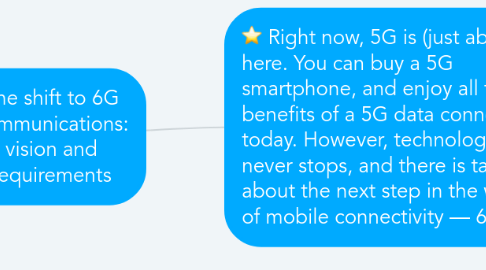
1. Right now, 5G is (just about) here. You can buy a 5G smartphone, and enjoy all the benefits of a 5G data connection today. However, technology never stops, and there is talk about the next step in the world of mobile connectivity — 6G.
1.1. When to expect 6G?
1.1.1. 6G is expected to launch commercially in 2030. 6G is being developed in response to the increasingly distributed radio access network (RAN) and the desire to take advantage of the terahertz (THz) spectrum to increase capacity, lower latency and improve spectrum sharing efficiency.
1.1.1.1. While some early discussions have taken place to define 6G, research and development (R&D) activities will start in earnest in 2020.
1.1.1.2. Many of the problems associated with deploying millimeter wave (MM wave) radio for 5G new radio are expected to be solved in time for network designers to address the challenges of 6G.
1.2. Is 6G real?
1.2.1. 6G (or whatever it’s eventually called) will eventually replace 5G, but 6G is not yet a functioning technology, and is instead in the early research phase. Mobile telecom companies are much too focused on 5G to deal with 6G in any significant way, although early research projects have begun thanks to funding from governments that want to gain an edge.
1.3. Is 6G needed?
1.3.1. More than ever before, the sixth generation of cellular networks will integrate a set of previously disparate technologies, including deep learning and big data analytics. The introduction of 5G paves the way for much of this convergence.
1.3.1.1. The need to deploy edge computing to ensure overall throughput and low latency for ultra-reliable, low latency communications solutions is an important driver for 6G, as is the need to support machine-to-machine communication in the internet of things (IoT).
1.3.1.1.1. Furthermore, a strong relationship has been identified between future 6G solutions and high-performance computing (HPC). While some of the IoT and mobile device data will be handled by edge computing resources, much of it will require processing by more centralized HPC resources.
1.4. Who is working on it?
1.4.1. The race to 6G will draw the attention of many industry constituents, such as major test and measurement vendor Keysight Technologies who has also indicated a commitment to its development. This may very well make the race to reach 5G look minor compared to the wait to see which countries can dominate the 6G technology market and its related applications, services and solutions.
1.4.1.1. The University of Oulu in Finland is committed to a 6G research initiative referred to as 6Genesis. The project will be conducted for the next eight years and will develop a vision for 2037.
1.4.1.2. South Korea’s Electronics and Telecommunications Research Institute is conducting research on the Terahertz frequency band for 6G and envisions data speeds 100 times faster than 4G LTE networks and 5 times faster than 5G networks.
1.4.1.3. The Ministry of Industry and Information Technology (MIIT) in China is directly investing and monitoring the research and development process.
1.4.1.4. The United States is planning to open up 6G frequency for R&D purposes pending approval from the Federal Communications Commission (FCC) for frequencies over 95 gigahertz (GHz) to 3 THz.
1.4.1.5. In terms of vendor commitments to 6G, major infrastructure companies such as Huawei, Nokia and Samsung have all signaled that they have R&D in the works.
1.5. What 6G will look like
1.5.1. It's expected that 6G wireless sensing solutions will selectively use different frequencies to measure absorption and adjust frequencies accordingly. This is possible because atoms and molecules emit and absorb electromagnetic radiation at characteristic frequencies and the emission and absorption frequencies are the same for any given substance.
1.5.1.1. 6G will have big implications for many government and industry solutions in public safety and critical asset protection such as:
1.5.1.1.1. Threat detection
1.5.1.1.2. Health monitoring
1.5.1.1.3. Feature and facial recognition
1.5.1.1.4. Decision making (in areas like law enforcement and social credit systems)
1.5.1.1.5. Air quality measurements
1.5.1.1.6. Gas and toxicity sensing
1.5.1.1.7. Improvements in these fields would also enable improvements in emerging technology such as smart cities, autonomous vehicles and virtual reality.
1.6. Future scope
1.6.1. 6G radio networks will provide the means of communication and data gathering necessary to accumulate information, but a systems approach will be required for the 6G technology market as a whole involving data analytics, artificial intelligence, and next generation computation capabilities via HPC and quantum computing.
1.6.1.1. In addition to profound changes within the RAN, the core communications network fabric will also transform as many new technologies converge with 6G. Most notably, AI will take center stage with 6G.
1.6.1.1.1. There is discussion regarding the potential for a so called “nano-core” to emerge as a common computing core that encompasses elements of both HPC and AI.
1.6.2. With substantially more data created by 6G than 5G networks, and the evolution of computing to include coordination between edge and core platforms, the need for datacenter evolution will be paramount.
1.6.2.1. Next generation 6G capabilities in the areas of sensing, imaging and location determination will generate vast amounts of data that must be managed on behalf of the network owners, service providers and data owners.
